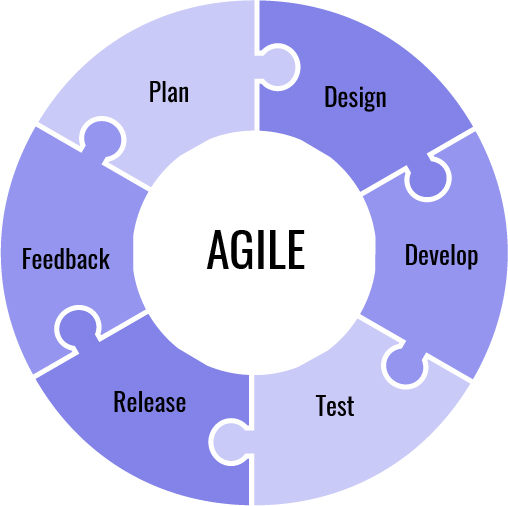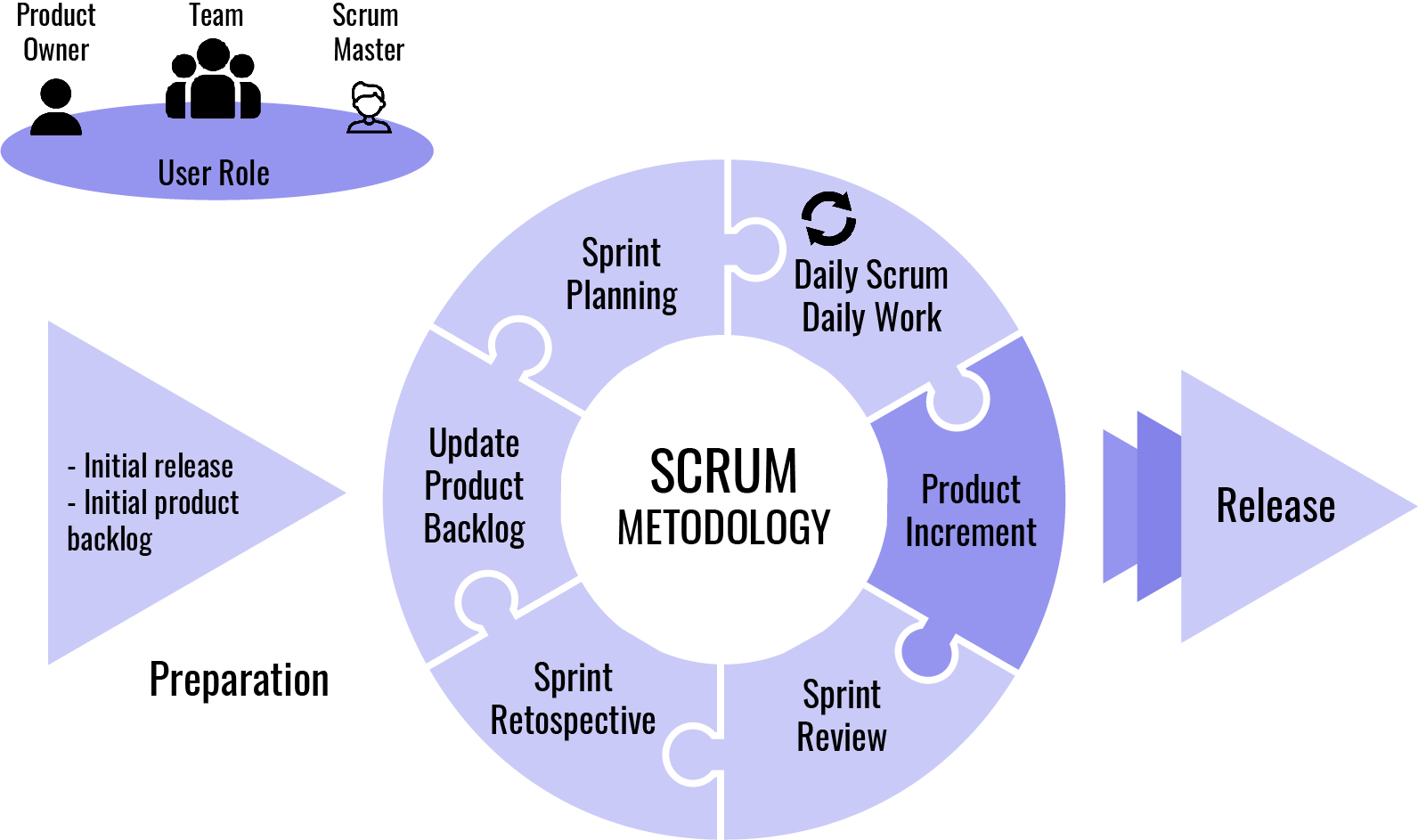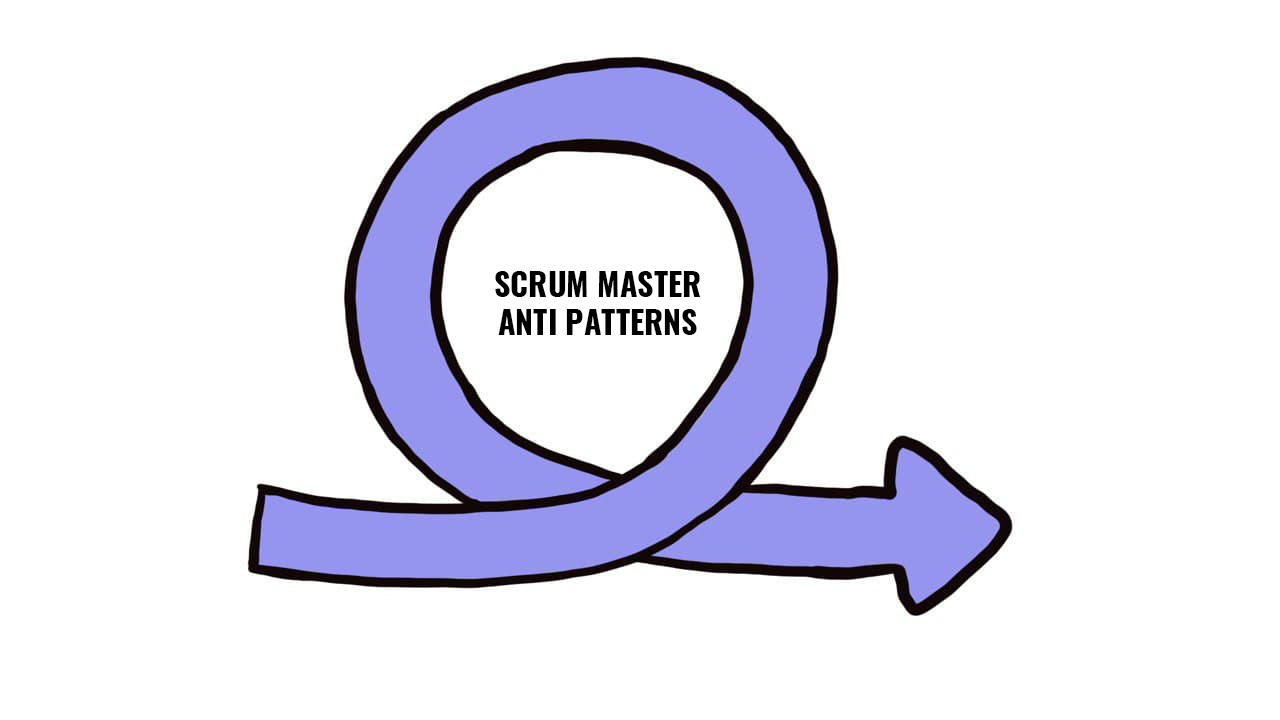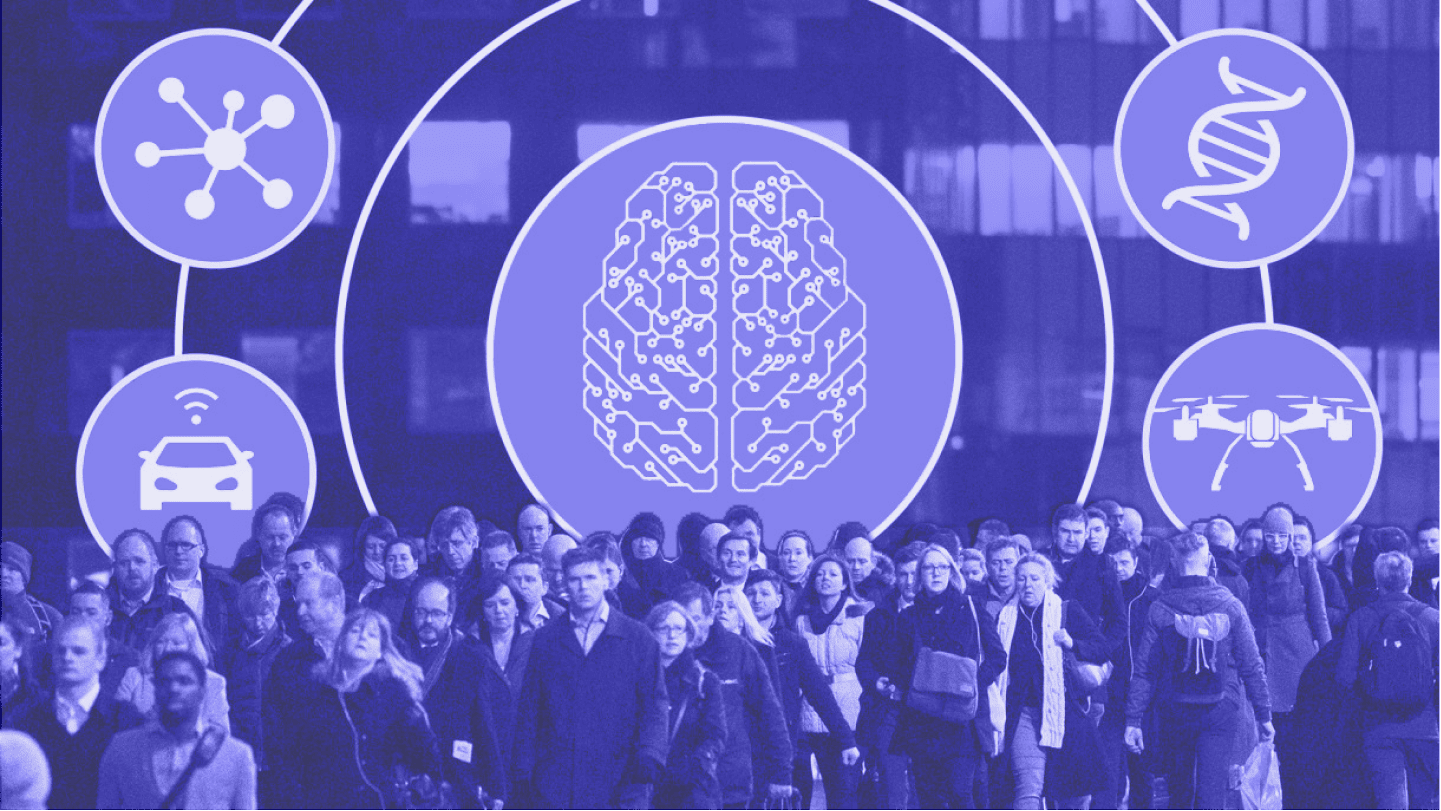It is a set of principles and approaches that direct an organization's resources to create products that require customers quickly.
Agile includes the Agile Manifesto, a document that provides a set of twelve Agile principles to formulate the Agile framework as a specific approach toward software development. Iteration or building upon the previous work process to satisfy clients is a core philosophy of Agile frameworks. One of the fundamental principles is to deliver software-related updates to customers as frequently as possible, ranging from two weeks to two months.
There are different methodologies within the Agile set of principles and values, including scrum, eXtreme Programming, Kanban, scaled Agile framework, lean, and several others. Let’s discuss the most popular one—scrum.
What Is Scrum?
If we want to put a formal definition to scrum, it is a framework where cross-functional teams in an organizational setting can work together in perfect synchronization. Experiential learning is highly encouraged in the scrum process while working on a problem. The scrum teams reflect on both their negative and positive outcomes to make necessary adjustments for continuous improvement.
The Scrum Guide has defined four events for a scrum framework called scrum events or scrum ceremonies. The events are as follows:
-
Sprint planning. It initiates the scrum team to come together and analyze the outcomes of high-priority work for the sprint and set a target.
-
Daily scrum. The team of developers meets on a regular basis, preferably every day for up to 15 minutes, to check their progress toward the sprint’s desired or target outcome.
-
Sprint review. Here, the participants of the scrum team get in and discuss completed work. The product backlog is adjusted as needed based on their opinion.
-
Sprint retrospective. It asks the team members to discuss what went right and scopes for future improvement. The team formulates specific plans for future process improvements and what tools to utilize.
Since we now know the scrum events, let’s look at scrum’s benefits.
Advantages of Scrum
1. Users get stable and usable products in a shorter time.
2. Greater quality is ensured.
3. Team productivity is better compared to typical processes.
4. More adaptiveness to changes as scrum ceremonies (events) take place frequently.
5. Employees are at a higher motivation level as they enjoy greater engagement through sprint planning.
6. User satisfaction is higher due to the early feedback collection through the iterative process.
7. It can easily be implemented in very complicated projects.
Scrum isn’t an ideal solution for every business. Now, we will see instances where scrum isn’t applicable.
Why Don’t Some People Like Scrum?
Have you ever tried to cut a baguette with a saw? We bet that would make you hate saws. The same is true with scrum. People apply it when it’s not applicable without being ready for the team state and without readiness to invest time to change their mindset. It is essential to understand that the organization/team has to be ready for this. For example, if your team can’t plan their work, it might be better to consider Kanban instead of scrum.
Many teams that use or try to use scrum don’t have a clear understanding of the principles that are the foundation of the framework and the real advantages of the correct usage. That’s why, first, you should decide if you need it at all.
There are quite a few reasons why you should avoid using scrum. Here are some of those potential scenarios when you should stay away from using it:
-
The environment is too simple. By definition, scrum is suitable for complex scenarios. So if your environment is not complex, there is no point in using scrum, as it will unnecessarily complicate things.
-
Stakeholders don’t accept changes to the sprint backlog. The scrum ideology suggests that teams learn from their previous experience and adjust their future goals accordingly. If the stakeholders are too rigid to accept changes, depending on the backlog items, then it is better to avoid the scrum process.
-
Development teams can’t take responsibility. If the development teams are not authorized to make decisions on their own, they will not be able to self-organize themselves.
-
Stakeholders won’t participate in the sprint reviews. As mentioned above, without the active participation of the stakeholders, scrum won’t be successful because the involvement of all parties is crucial on a scrum team.
The scrum essentials bring us to the topic of the scrum process.
What Is the Scrum Process?
The scrum process is a development framework that meets the clients’ requirements by establishing transparent communication, team responsibility, and iterative learning and improvement. A scrum project comprises well-defined activities and flows of processes. There are five critical phases within a scrum process, which are:
-
Establish the product backlog.
-
The product owner and development team conduct sprint planning. Determine the scope of the sprint in the first part of sprint planning and the plan for delivering that scope in the second half of sprint planning.
-
As the sprint progresses, the development team performs the work necessary to deliver the selected product backlog items.
-
On a daily basis, the development team coordinates their work in a daily scrum.
-
At the end of the sprint, the development team delivers the product backlog items selected during sprint planning. The development team holds a sprint review to show the customer the increment and get feedback. The development team and product owner also reflect on how the sprint has proceeded so far and adapt their processes accordingly during a retrospective.
The development team continues to repeat phases two to five above until the final outcome fully meets the set standard. Now that processes are known, there are several scrum terminologies, known as scrum artifacts, that we need to discuss at this stage.
Scrum Artifacts
Artifacts are something we make, like a tool to solve a problem. There are three artifacts for scrum:
-
Product backlog. It is an organized list of everything required to build a project plan, similar to a checklist. The list is evolved on a continuous basis without being labeled “complete.” It contains elements like market demand, customer support, and competitor analysis.
-
Sprint backlog. It is a list of tasks from the product backlog. Development teams divide big product backlog tasks into mini actionable tasks that are updated regularly. If a development team can't cope with a number of sprint tasks, they can be postponed to future sprints.
-
Product increment. Once product backlog items during a sprint are over, the team has to perform a releasable product improvement or sample, complying with their agreed-upon outcome.
Now that you have a basic knowledge of scrum, you are ready to learn about the main topic of this article—scrum master.
What Is a Scrum Master?
The Scrum Guide portrays scrum masters as a servant leader on a scrum team whose role is to facilitate workflow and communication between members of the scrum team and the product owner. The main task of a scrum master is to establish the scrum in accordance with the Scrum Master Guide. Helping everyone involved in the process better understand the scrum theories and practice is a major responsibility of a scrum master.
Scrum Master’s role in an Agile environment is as follows:
Serving the Scrum Team
An Agile methodology scrum master is responsible for ensuring the effectiveness and efficiency of the Agile teams by playing the role of an Agile coach. Being a dynamic leader is also a core part of the responsibility. Following the scrum framework, they help the scrum team improve on its functionalities.
There are several ways to that, such as add:
-
Training the team on how to self-monitor projects on a diversified and cross-functional team.
-
Helping remove any obstacles that may harm the team’s functionalities.
-
Coaching the team members on how to make high-impact improvements on their work to meet the set standard.
-
Maintaining the productivity, schedule, and efficiency of scrum events.
Serving the Product Owner
There are several ways a scrum master serves the product owner, such as:
-
Assisting with how to define a good product goal and coordinate the product backlog.
-
Assisting the team members with learning how the clarity of product backlog items is crucial for success.
-
Coordinating necessary communication with all involved parties.
-
Assisting with forming sequential product planning within a complex team.
Serving the Organization
Now, let's take a look at how the scrum master serves the organization:
-
Mentoring and coaching the organization to learn and integrate scrum practices.
-
Suggesting how the organization can implement scrum within its operations.
-
Assisting all the involved parties, from employees to clients, in understanding the usability of a well-coordinated scrum approach.
-
Addressing all the obstacles that hinder communication between stakeholders and the development team.
As it turns out, the roles of a scrum master are critical to the success of a development team. This may raise a logical question: what skills are needed to be a valuable scrum master.
Skills of a Scrum Master
Some of the fundamental scrum master qualities are consolidated in the following list, which will give you a good idea of what to look for when you search for a good candidate for this position:
-
Influence. Leadership is the core responsibility of a scrum master. Hence, the person must have the ability to motivate and influence others.
-
Collaboration. A scrum master should always ensure that the project team members and the project owner remain on the same page and coordination is always smooth.
-
Observation. Having a clear idea of every individual’s contribution to the project is an important skill that a scrum master needs to possess.
-
Knowledge. There are some technical skills and knowledge that a scrum master should have, such as Jira software development skills and project management skills. A skilled scrum master shares Agile principles and fosters them.
What responsibilities should you talk about with a prospective scrum master who wants to join your team? Continue reading.
Scrum Master's Responsibilities
To give you a clear picture of what to expect from a scrum master, let’s take a look at the following list to learn about the responsibilities of a scrum master, according to the Scrum Guide.
-
Coaching. A scrum master plays the role of a coach or mentor for the team members.
-
Coordinating events. The scrum master follows up with the team members to ensure that the daily events and scrum meetings take place on a regular basis.
-
Servant leader. Being a servant leader, a scrum master acts as the authority for interactions with the team and product owner.
-
Product backlog coordination. The scrum master coordinates with the product owner and keeps track of the product backlog and production support.
-
Dealing with obstacles. The scrum master helps the team overcome any difficulties and unforeseen events. As a dynamic leader, a scrum master forsters independence within the team.
-
Implementing scrum. Teaching and maintaining the scrum principles within the team is the responsibility of a scrum master.
Now that responsibilities and skills are clear, you may ask: what are mistakes or, in other words, anti-patterns of a scrum master that can badly influence a development team’s workflow?
Main Scrum Master Anti-Patterns
The following list shows some mistakes or anti-patterns from scrum masters that might hurt your team’s progress and efficiency.
1. Tailoring too much. Although, ideologically, scrum processes are customizable, making too many modifications along the way may jeopardize the team’s balance on an organizational level, for example, making frequent changes to the duration of sprint events or changing their location.
2. Dissatisfaction with the status quo. If a scrum master is not a proactive person and doesn't like changes or constantly avoids them, it will definitely create problems for the scrum team. The job of a scrum master is to encourage the team to find the golden mean in new changes and improvement ideas.
3. Extending a helping hand too long. By getting involved in every matter, resolving issues, or offering too many tips, a scrum master interferes with other people's problems. It usually happens when a scrum master previously worked as a project manager and had different responsibilities. Such actions will decrease the potential of the team members, encouraging them to pass off the problems instead of resolving them.
4. Competing against other teams. The scrum master needs to focus on team results and motivate them without competing with other teams in a similar niche. The scrum master’s team might have a fear of being defeated.
5. Conflict aversion. A scrum master needs to agree that conflicts can be inevitable on any team, and scrum teams are no exception. So, it is a good idea to resolve conflicts instead of avoiding them.
6. Not updating retrospective formats in sprints. The scrum master needs to update the retrospective formats in sprints for continuous improvement frequently. That creates the possibility to think out of the box and look at problems from different angles. Sticking with just one format is a fundamental mistake.
7. Unwelcome to criticism. Being unwelcome to criticism or challenges will make the scrum master lose sight of potential scopes for improvement, which will eventually hinder the team’s performance.
8. Failure to create leadership. By assigning specific tasks to team members instead of allowing them to take responsibility, a scrum master will fail to achieve the full potential of scrum teams. Just remember that there are no bosses in scrum.
Knowing the pitfalls of the scrum master position will help you improve the development process. And now you may ask if it’s difficult to start a career as a scrum master; let’s see.
How to Become a Scrum Master
1. To become a scrum master, first, you will need to learn the scrum framework. Online resources are abundant for this purpose. Also, there are a lot of useful books on the subject.
There are several certifications available to become a scrum master practitioner, such as:
a. Certified Scrum Master (CSM);
b. Professional Scrum Master (PSM);
c. Agile Project and Delivery Management Certification (ICP-APM).
2. Secondly, you can decide on what certification to pursue and then sign up for it. The cost will vary. For instance, a CSM, or Certified Scrum Master, training course usually costs between $1,000 to $2,000 and takes a couple of days to complete.
However, like any professional, a scrum master must always remember that having a certification is not the end of learning; rather, it is just the beginning. There is no alternative to constantly expanding their competencies through continuous learning and training.
Certification
Upon completion of the training courses, you will need to pass the CSM exam and score at least 74% for membership certification, which is valid for two years and can be renewed afterward.
Salary
The scrum master salary structure is lucrative and very competitive, indeed. The following list will give you a good estimate of the salary structure for scrum masters across different regions:
-
United States: USD 106,791
-
Singapore: USD 102,626
-
Australia: USD 73,978
-
United Kingdom: USD 64,000
-
Canada: USD 63,264
-
New Zealand: USD 61,696
-
South Africa: USD 30,631
-
China: USD 30,209
-
India: USD 19,966
While we talk about maintaining good employee morale in a scrum setting, having a great team velocity is crucial for achieving project outcomes efficiently, as described by Geniusee. You may also be thinking about where you can find great support if you want to implement scrum in a company. That’s where Geniusee comes in.
Improve Teamwork with Geniusee
For a successful outcome, team velocity calculation in scrum is a crucial cornerstone that you cannot miss. With Geniusee, you can accomplish the following goals easily to improve your teamwork in compliance with methodologies specified in the Scrum Guide:
-
Track the total amount of reported team efforts completed for each sprint.
-
Forecast how much backlog effort the team can deal with in future sprints if its formation and sprint duration remain constant.
It’s obvious now that Geniusee can help scrum masters improve their efforts and make the development team’s workflow smoother.
Summary
Scrum is a good practice from the process perspective—you can use all ceremonies to maintain transparency and adapt quickly. On the next level, it also includes deeper elements underlying those process attributes.
With a diversified portfolio of skills, scrum masters implement Agile best practices to enhance team efficiency and quality of product deliverables. So, if you want to become a scrum master and have a dedicated development team in your company, Geniusee will be a useful tool to assist you!

























